新概念英语第一册知识点总结-
新概念英语第一册各课语法知识汇总
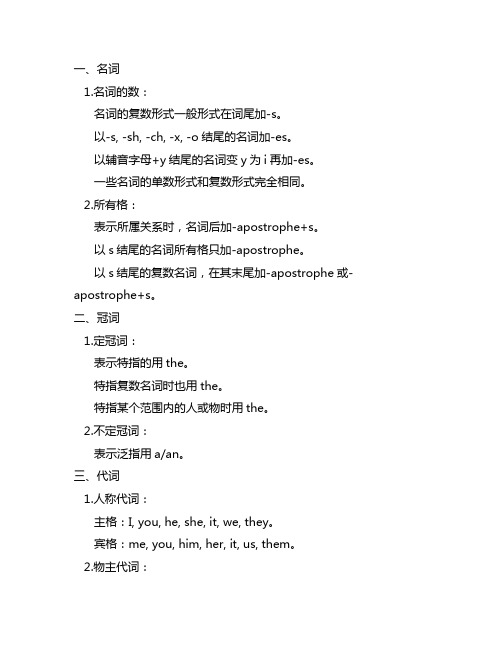
一、名词1.名词的数:名词的复数形式一般形式在词尾加-s。
以-s, -sh, -ch, -x, -o结尾的名词加-es。
以辅音字母+y结尾的名词变y为i再加-es。
一些名词的单数形式和复数形式完全相同。
2.所有格:表示所属关系时,名词后加-apostrophe+s。
以s结尾的名词所有格只加-apostrophe。
以s结尾的复数名词,在其末尾加-apostrophe或-apostrophe+s。
二、冠词1.定冠词:表示特指的用the。
特指复数名词时也用the。
特指某个范围内的人或物时用the。
2.不定冠词:表示泛指用a/an。
三、代词1.人称代词:主格:I, you, he, she, it, we, they。
宾格:me, you, him, her, it, us, them。
2.物主代词:形容词性物主代词:my, your, his, her, its, our, their。
名词性物主代词:mine, yours, his, hers, its, ours, theirs。
3.指示代词:this, that, these, those。
4.不定代词:some, any, no, every, each, many, much, few, little。
四、形容词1.形容词的用法:在名词前作定语。
在系动词之后作表语。
2.比较级和最高级:比较级:比较两者时,用比较级。
最高级:表示三者或三者以上之间的比较。
五、动词1.动词的三单形式:一般情况,动词第三人称单数在末尾加-s。
以辅音字母加y结尾的动词变y为i再加-es。
直接在词尾加-es的动词。
2.动词的现在进行时:am/is/are+动词的现在分词。
3.行为动词的过去式:动词过去式变化规则有规则动词和不规则动词。
六、副词1.副词的用法:修饰动词、形容词、副词。
表示时间、地点、原因、目的等。
2.比较级和最高级:副词比较级和最高级的构成。
七、介词1.介词的基本用法:表示方位、时间、原因、目的等。
新概念第一册语法总结 新概念英语第一册知识点
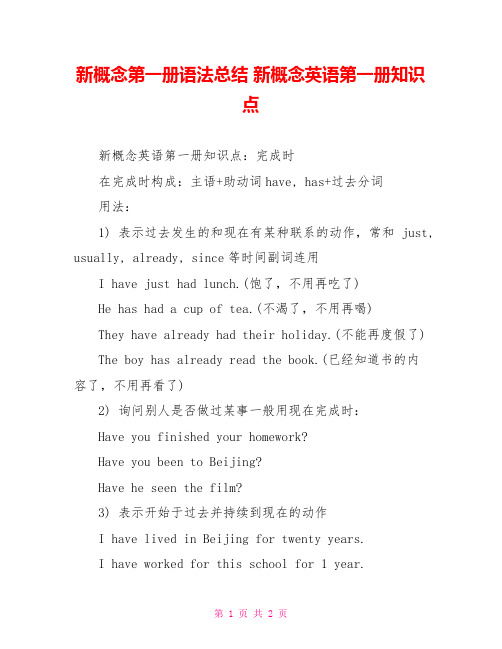
新概念第一册语法总结新概念英语第一册知识点新概念英语第一册知识点:完成时在完成时构成:主语+助动词have, has+过去分词用法:1) 表示过去发生的和现在有某种联系的动作,常和just, usually, already, since等时间副词连用I have just had lunch.(饱了,不用再吃了)He has had a cup of tea.(不渴了,不用再喝)They have already had their holiday.(不能再度假了) The boy has already read the book.(已经知道书的内容了,不用再看了)2) 询问别人是否做过某事一般用现在完成时:Have you finished your homework?Have you been to Beijing?Have he seen the film?3) 表示开始于过去并持续到现在的动作I have lived in Beijing for twenty years.I have worked for this school for 1 year.4) 表示一种经历,经验:去过...地方,做过...事情,经历过...事情I have never had a bath.I have never seen a film.I have never been to cinema.I have ever been to Paris.Have been to表示去过,have gone to 表示去了I have been to London.(人已经回来)He has gone to London.(人还在那里)5) 表示一种结果,一般不和时间副词联用I have lost my pen.I have hurt myself.He has bee a teacher.She has broken my heart.句型变化:。
(完整版)新概念英语第一册重点语法知识点
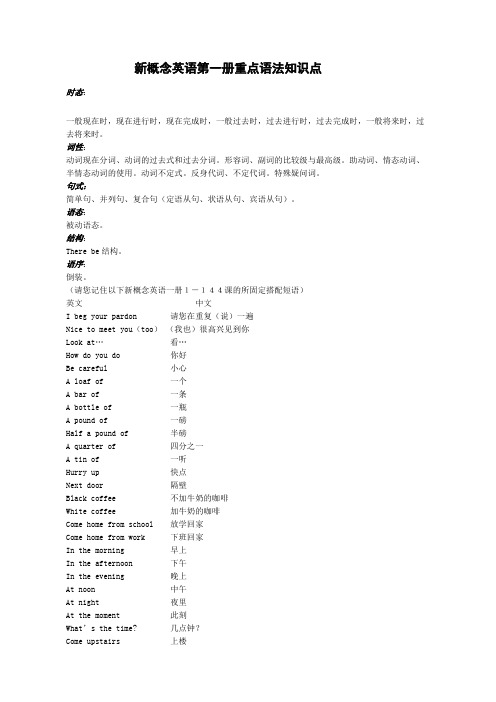
它自己
By ourselves
我们自己
By yourselves
你们自己
By themselves
他/她/它们自己
By oneself
独自的
Not that long ago 没那么久
At…
(以…的方式进行、做某事)
He can’t be…
他不可能…
He must be
他肯定是…
He can’t have been…
循着以下规则
1、
一般情况下单音节的形容词或副词则在原形未尾加“er”。
2、
如果以 e 结尾的形容词或副词则加“r”。
3、
有些以 y 结尾的双音节词,如果 y 前面是一个辅音字母则变“y”为“i”在加“er”。
(如果是最高级则在形容词前加冠词“The”然后形容词或副词未尾加“est”,其它规则一样。)
分名词可直接加“s”)
7、
以 o 结尾的名词一般加“s”。(部分以辅音字母+o 结尾的加“es”)
二、
规则动词的过去式与过去分词变化与动词现在分词的变化
1、
一般动词过去式在未尾加“ed”。
2、
结尾是 e 的动词加“d”。
3、
未尾只有一个辅音字母的重读闭音节词,先双写这个辅音字母,再加“ed”。
4、
结尾是辅音字母+y 的动词,先变“y”为“i”在加“ed”。
烟头
Take out
拿出
Put away
放到一边
Hundreds of…
成百上千的…
Round the world
周游世界
季节、月份、星期
Spring
春节
Summer
(完整版)新概念英语第一册知识点总结-

第一册重点语法知识点都包含:时态:一般现在时,现在进行时,现在完成时,一般过去时,过去进行时,过去完成时,一般将来时,过去将来时。
词性:动词现在分词、动词的过去式和过去分词。
形容词、副词的比较级与最高级。
助动词、情态动词、半情态动词的使用。
动词不定式。
反身代词、不定代词。
特殊疑问词。
句式:简单句、并列句、复合句(定语从句、状语从句、宾语从句)。
语态:被动语态。
结构:There be结构。
语序:倒装。
(新概念英语一册1-144课的所固定搭配短语)I beg your pardon 请您在重复(说)一遍 Nice to meet you(too)(我也)很高兴见到你Look at…看… How do you do 你好 Be careful 小心A loaf of 一个 A bar of 一条 A bottle of 一瓶 A pound of一磅 Half a pound of 半磅 A quarter of 四分之一 A tin of 一听 Hurry up 快点 Next door 隔壁 Black coffee 不加牛奶的咖啡White coffee 加牛奶的咖啡 Come home from school 放学回家Come home from work 下班回家 At the moment 此刻What‟s the time? 几点钟? Come upstairs 上楼 Come downstairs 下楼Hundreds of…数以百计的… On the way home 在回家的途中This morning 今天早晨 This afternoon 今天下午This evening 今天晚上 tonight 今天夜里Yesterday morning 昨天早晨 Yesterday afternoon 昨天下午 Yesterday evening昨天晚上 Last night 昨天夜里The day before yesterday in the morning 前天早晨The day before yesterday in the afternoon 前天下午The day before yesterday in the evening 前天晚上The night before last 前天夜间A low mark 分数很底 A high mark 分数很高 She said to herself 她心中暗想 The way to…到…的走法In fashion 流行的,时髦的I‟m afraid…我恐怕…I‟m sure…我确信,我肯定… A lot of 许多(用于肯定句)At all 丝毫、更本、一点也不 Going on holiday 度假Have been to…到过… All the time 一直,始终Have been to…到过… Drive into…撞倒…For sale 供出售、出售 Have the last word 最后决定、最后才算The R.A.F. 英国皇家空军 Return ticket 往返票Next door to…与…相邻,在…隔壁 In five hours‟time在五小时之后。
新概念英语第一册语法知识点
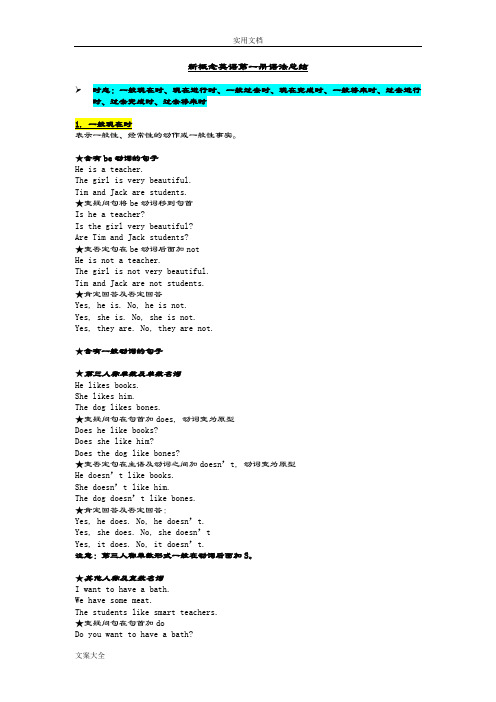
新概念英语第一册语法总结时态:一般现在时、现在进行时、一般过去时、现在完成时、一般将来时、过去进行时、过去完成时、过去将来时★含有be动词的句子He is a teacher.The girl is very beautiful.Tim and Jack are students.★变疑问句将be动词移到句首Is he a teacher?Is the girl very beautiful?Are Tim and Jack students?★变否定句在be动词后面加notHe is not a teacher.The girl is not very beautiful.Tim and Jack are not students.★肯定回答及否定回答Yes, he is. No, he is not.Yes, she is. No, she is not.Yes, they are. No, they are not.★含有一般动词的句子★第三人称单数及单数名词He likes books.She likes him.The dog likes bones.★变疑问句在句首加does, 动词变为原型Does he like books?Does she like him?Does the dog like bones?★变否定句在主语及动词之间加doesn’t, 动词变为原型He doesn’t like books.She doesn’t like him.The dog doesn’t like bones.★肯定回答及否定回答:Yes, he does. No, he doesn’t.Yes, she does. No, she doesn’tYes, it does. No, it doesn’t.注意:第三人称单数形式一般在动词后面加S。
★其他人称及复数名词I want to have a bath.We have some meat.The students like smart teachers.★变疑问句在句首加doDo you want to have a bath?Do we have any meat?Do the students like smart teachers?★变否定句在主语和动词之间加don’t.You don’t want to have a bath.We don’t have any meat.The students don’t like smart teachers.★肯定回答及否定回答Yes, I do. No, I don’t.Yes, we do. No, we don’tYes, they do. No, they don’t.构成:主语+be动词+动词的现在分词+其它成分We are having lunch.He is reading a book.The dog is running after a cat.The boys are swimming across the river.★变疑问句将be动词移到句首Are we having lunch?Is he reading a book?Is the dog running after a cat?Are the boys swimming across the river?★变否定句在be动词后面加notWe are not having lunch.He is not reading a book.The dog is not running after a cat.The boys are swimming across the river.★特殊疑问句:what, which, how, where, who, etc.疑问词+be动词+主语+现在分词What are you doing?What is she doing?What is the dog doing?没有进行时的动词(必背)表示状态、思想、感情、感觉的动词不能表示正在进行的动作1. 表示感觉、感官的词see, hear, like, love, want2. have, has作为动词”拥有”的含义时,没有进行时常和表示过去的时间状语连用,如yesterday, last night, the day before yesterday, three days ago.含有be动词的句子,将动词变为过去式,am / is的变为was,are的变为wereI was at the butcher’s.You were a student a year ago.The teacher was very beautiful ten years ago.★变疑问句将be动词移动到句首Were you at the butcher’s?Were you a student a year ago?Was the teacher very beautiful ten years ago?★变否定句在be动词后面加notI was not at the butcher’s.You were not a student a year ago.The teacher was not very beautiful ten years ago.★肯定回答否定回答Yes, I was. No, I was not.Yes, you were. No, you were not.Yes, he/she was. No, he/she was not.★特殊疑问句:What did you do?不含有be动词的句子,将动词变为过去式,动词过去式构成见附录I finished my homework yesterday.The boy went to a restaurant.The Sawyers lived at King Streeta year ago.King Streeta year ago.★变疑问句在句首加did,动词变为原型Did you finish your homework yesterday?Did the boy go to a restaurant?Did the Sawyers live at King Streeta year ago?King Streeta year ago?★变否定句在主语和动词之间加did not,动词变为原型I did not finish my homework yesterday.The boy did not go to a restaurant.The Sawyers did not live at King Streeta year ago.King Streeta year ago.★肯定回答及否定回答Yes, I did. No, I didn’t.Yes, he did. No, he didn’t.Yes, they did. No, they did not.have/has+过去分词用法:1)表示过去发生且和现在有某种联系的动作,常和just, usually, already, since等时间副词连用I have just had lunch. (饱了,不用再吃了)He has had a cup of tea.(不渴了,不用再喝)They have already had their holiday. (不能再度假了)The boy has already read the book. (已经知道书的内容了,不用再看了)2)询问别人是否做过某事一般用现在完成时Have you finished your homework?Have you been to Beijing?Have he seen the film?3)表示开始于过去并持续到现在的动作I have lived in Beijing for twenty years.I have worked for this school for 1 year.4)表示一种经历、经验:去过…地方,做过…事情,经历过…事情I have never had a bath.I have never seen a film.I have never been to cinema.I have ever been to Paris.Have been to表示去过,have gone to 表示去了I have been to London.(人已经回来)He has gone to London.(人还在那里)5)表示一种结果,一般不和时间副词联用I have lost my pen.I have hurt myself.He has become a teacher.She has broken my heart.句型变化:★变疑问句将助动词移到句首,变否定句在助动词后面加not.Have you lost your pen? I have not lost my pen.★肯定回答及否定回答Yes, I have. No, I have not.★特殊疑问句:What have you done?What has he done?一般过去时与现在完成时的区别:凡是有明确的表示过去的时间状语的句子为过去时注意:有些动词表示的动作有一个终点,不能再延续,因此不能和表示一段时间状语连用错:I’ve left Beijing for 3 days.对:I left Beijing 3 days ago. I have been away from being for 3 days.经常和tomorrow, next year, the day after tomorrow, the year after the next, in five hours’ time, etc. 表示将来的词联用结构:主语+助动词will+动词原形I will go to America tomorrow.The pilot will fly to Japan the month after the next.Jack will move into his new house tomorrow morning.★变疑问句将助动词移到句首Will you go to America tomorrow?Will the pilot fly to Japan the month after the next?Will Jack move into his new house tomorrow morning?★变否定句在助动词后面加notI will not go to America tomorrow.The pilot will not fly to Japan the month after the next.Jack will not move into his new house tomorrow morning★肯定回答及否定回答Yes, I will. No, I will not.Yes, he/she will. No, he/she will not.Yes, he will. No, he will not.★特殊疑问句:What will you do?结构:had+过去分词After she had finished her homework, she went shopping.They had sold the car before I asked the price.The train had left before I arrived at the station.After/before引导的时间状语从句放在句首要在句子后面加逗号,如果放在主句后则不用。
新概念一册全部知识点总结

新概念一册全部知识点总结第一部分:基本单词和短语新概念一册的基本单词和短语分为多个单元,每个单元都围绕一个主题展开,学生在学习过程中将学会一定数量的基本单词和短语,并通过例句来掌握它们的用法和语境。
常见的主题包括家庭、学校、颜色、数字、动物、食物等。
第二部分:语法知识1. 名词:单数、复数、所有格、不可数名词的使用;2. 冠词:定冠词和不定冠词的使用;3. 代词:人称代词、物主代词、反身代词的用法;4. 动词:动词的时态、语态、不定式、动名词等;5. 形容词和副词:形容词和副词的比较级、最高级、修饰语法;6. 数词:基数词、序数词、分数词的用法;7. 介词:介词短语和介词的用法;8. 连词:并列连词、从属连词的用法。
第三部分:句型结构1. 肯定句:主语+谓语+宾语;2. 否定句:主语+助动词+否定词+谓语+宾语;3. 疑问句:一般疑问句、特殊疑问句的结构;4. 强调句:强调句的结构和用法;5. 祈使句:祈使句的结构和用法。
第四部分:阅读和理解新概念一册的阅读和理解部分包括一些简短的文章和对话,学生需要通过阅读理解来掌握文章的主题、要点和细节,并学会提取信息、做笔记、进行总结等技能。
第五部分:口语表达口语表达是新概念一册的重要内容之一,学生需要通过对话练习和角色扮演来提高自己的口语表达能力,包括问路、购物、介绍自己、谈论兴趣爱好等。
第六部分:听力训练新概念一册的听力训练部分主要包括一些简短的对话和独白,学生需要通过听力训练来提高自己的听力理解能力,并学会提取信息、概括主旨、回答问题等技能。
第七部分:写作技巧写作技巧是新概念一册的另一个重要内容,学生需要通过一些写作练习来提高自己的写作水平,包括书信、日记、口头通知等。
第八部分:语言运用语言运用是新概念一册的最后一个部分,学生需要通过语言运用来巩固和复习所学的知识点,包括语法练习、词汇练习、阅读理解练习等。
总结:新概念一册的知识点主要包括基本单词和短语、语法知识、句型结构、阅读和理解、口语表达、听力训练、写作技巧和语言运用等内容。
最全的新概念英语第一册语法汇总
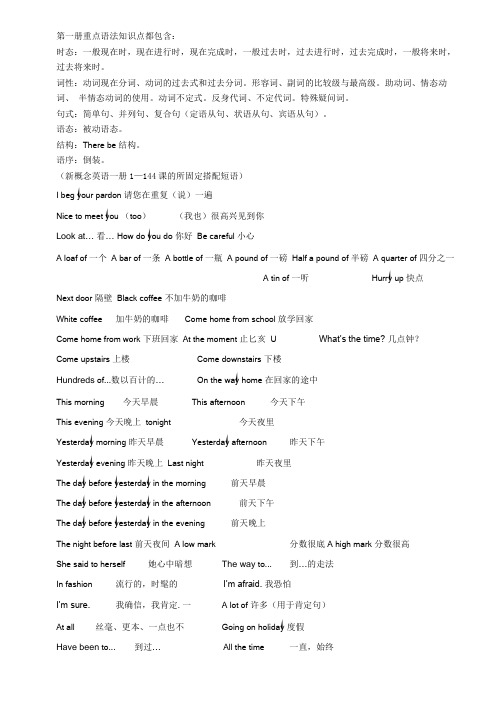
第一册重点语法知识点都包含:时态:一般现在时,现在进行时,现在完成时,一般过去时,过去进行时,过去完成时,一般将来时,过去将来时。
词性:动词现在分词、动词的过去式和过去分词。
形容词、副词的比较级与最高级。
助动词、情态动词、半情态动词的使用。
动词不定式。
反身代词、不定代词。
特殊疑问词。
句式:简单句、并列句、复合句(定语从句、状语从句、宾语从句)。
语态:被动语态。
结构:There be结构。
语序:倒装。
(新概念英语一册1—144课的所固定搭配短语)I beg your pardon 请您在重复(说)一遍Nice to meet you (too)(我也)很高兴见到你Look at… 看… How do you do 你好Be careful 小心A loaf of 一个 A bar of 一条 A bottle of 一瓶 A pound of 一磅Half a pound of 半磅 A quarter of 四分之一A tin of 一听Hurry up 快点Next door 隔壁Black coffee 不加牛奶的咖啡White coffee 加牛奶的咖啡Come home from school放学回家Come home from work 下班回家At the moment 止匕亥U What’s the time? 几点钟?Come upstairs 上楼Come downstairs 下楼Hundreds of...数以百计的…On the way home 在回家的途中This morning 今天早晨This afternoon 今天下午This evening 今天晚上tonight 今天夜里Yesterday morning 昨天早晨Yesterday afternoon 昨天下午Yesterday evening 昨天晚上Last night 昨天夜里The day before yesterday in the morning 前天早晨The day before yesterday in the afternoon 前天下午The day before yesterday in the evening 前天晚上The night before last 前天夜间 A low mark 分数很底A high mark 分数很高She said to herself 她心中暗想The way to... 到…的走法In fashion 流行的,时髦的I’m afraid. 我恐怕I’m sure.我确信,我肯定.一 A lot of 许多(用于肯定句)At all 丝毫、更本、一点也不Going on holiday 度假Have been to... 到过…All the time 一直,始终Have been to…到过…Drive into…撞倒.•・For sale 供出售、出售Have the last word 最后决定、最后才算The R.A.F. 英国皇家空军Return ticket 往返票Next door to... 与..•相邻,在..•隔壁In five hours’time在五小时之后。
新概念英语第一册所有语法点汇总)
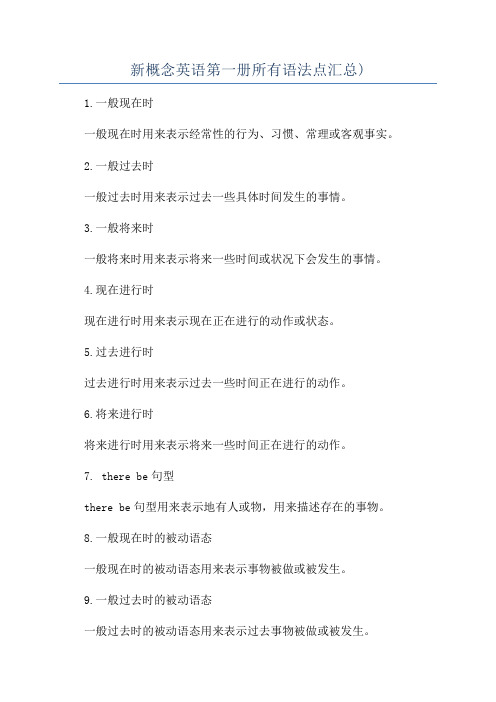
新概念英语第一册所有语法点汇总)1.一般现在时一般现在时用来表示经常性的行为、习惯、常理或客观事实。
2.一般过去时一般过去时用来表示过去一些具体时间发生的事情。
3.一般将来时一般将来时用来表示将来一些时间或状况下会发生的事情。
4.现在进行时现在进行时用来表示现在正在进行的动作或状态。
5.过去进行时过去进行时用来表示过去一些时间正在进行的动作。
6.将来进行时将来进行时用来表示将来一些时间正在进行的动作。
7. there be句型there be句型用来表示地有人或物,用来描述存在的事物。
8.一般现在时的被动语态一般现在时的被动语态用来表示事物被做或被发生。
9.一般过去时的被动语态一般过去时的被动语态用来表示过去事物被做或被发生。
10.一般将来时的被动语态一般将来时的被动语态用来表示将来事物将被做或被发生。
11.现在进行时的被动语态现在进行时的被动语态用来表示事物正在被做或被发生。
12.过去进行时的被动语态过去进行时的被动语态用来表示过去事物正在被做或被发生。
13. do与does的用法do和does用来构成否定句、疑问句和回答。
14.现在完成时现在完成时用来表示过去发生的动作对现在造成的影响或结果。
15.现在完成进行时现在完成进行时用来表示从过去开始一直延续到现在的动作,且这个动作可能还会继续下去。
16.过去完成时过去完成时用来表示过去在一些时间或事件之前已经完成的动作。
17.过去完成进行时过去完成进行时用来表示过去一些时间持续进行的动作,这个动作在另一个过去时间之前已经结束。
18.表示数量的词表示数量的词包括数词、基数词、序数词、分数和百分数等。
19.表示频率的词表示频率的词用来描述件事情发生的频率,如常常、经常、有时、很少、从不等。
20.表示时间的词表示时间的词用来描述一些事件发生的时间,如年、月、日、星期、时、分、秒等。
21.表示地点的词表示地点的词用来描述一些事件发生的地点,如国家、城市、街道、大楼等。
新概念1知识点归纳总结
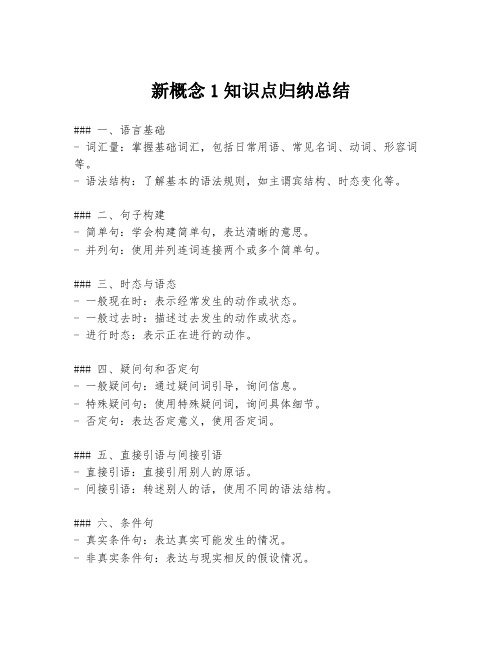
新概念1知识点归纳总结### 一、语言基础- 词汇量:掌握基础词汇,包括日常用语、常见名词、动词、形容词等。
- 语法结构:了解基本的语法规则,如主谓宾结构、时态变化等。
### 二、句子构建- 简单句:学会构建简单句,表达清晰的意思。
- 并列句:使用并列连词连接两个或多个简单句。
### 三、时态与语态- 一般现在时:表示经常发生的动作或状态。
- 一般过去时:描述过去发生的动作或状态。
- 进行时态:表示正在进行的动作。
### 四、疑问句和否定句- 一般疑问句:通过疑问词引导,询问信息。
- 特殊疑问句:使用特殊疑问词,询问具体细节。
- 否定句:表达否定意义,使用否定词。
### 五、直接引语与间接引语- 直接引语:直接引用别人的原话。
- 间接引语:转述别人的话,使用不同的语法结构。
### 六、条件句- 真实条件句:表达真实可能发生的情况。
- 非真实条件句:表达与现实相反的假设情况。
### 七、非谓语动词- 动名词:动词+ing形式,用作名词。
- 不定式:to+动词原形,表示目的或意图。
- 分词:现在分词(-ing形式)和过去分词(-ed形式),用作形容词。
### 八、定语从句- 限制性定语从句:对先行词进行限定。
- 非限制性定语从句:对先行词进行补充说明。
### 九、状语从句- 时间状语从句:表示动作发生的时间。
- 原因状语从句:说明动作发生的原因。
- 条件状语从句:表示动作发生的条件。
### 十、虚拟语气- 对现在情况的虚拟:表示与现实相反的愿望或假设。
- 对过去情况的虚拟:表示对过去的遗憾或假设。
### 十一、文章结构- 引言:文章开头,提出主题。
- 主体:详细阐述主题,提供论据。
- 结论:文章结尾,总结全文。
### 十二、写作技巧- 段落结构:每个段落包含主题句和支持句。
- 逻辑连接:使用逻辑连接词使文章更加连贯。
通过对新概念1的知识点进行归纳总结,可以更好地掌握英语基础,为进一步学习打下坚实的基础。
新概念英语第一册知识点汇总
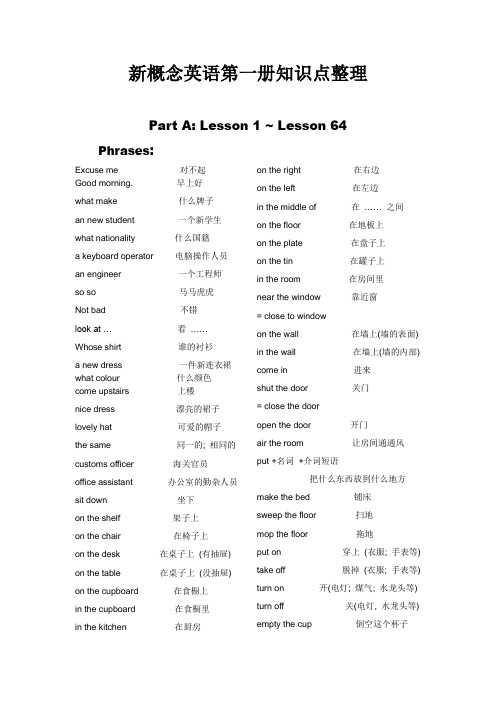
新概念英语第一册知识点整理Part A: Lesson 1 ~ Lesson 64 Phrases:Excuse me 对不起Good morning. 早上好what make 什么牌子an new student 一个新学生what nationality 什么国籍a keyboard operator 电脑操作人员an engineer 一个工程师so so 马马虎虎Not bad 不错look at … 看……Whose shirt 谁的衬衫a new dress 一件新连衣裙what colour 什么颜色come upstairs 上楼nice dress 漂亮的裙子lovely hat 可爱的帽子the same 同一的; 相同的customs officer 海关官员office assistant 办公室的勤杂人员sit down 坐下on the shelf 架子上on the chair 在椅子上on the desk 在桌子上(有抽屉)on the table 在桌子上(没抽屉)on the cupboard 在食橱上in the cupboard 在食橱里in the kitchen 在厨房on the right 在右边on the left 在左边in the middle of 在…… 之间on the floor 在地板上on the plate 在盘子上on the tin 在罐子上in the room 在房间里near the window 靠近窗= close to windowon the wall 在墙上(墙的表面) in the wall 在墙上(墙的内部) come in 进来shut the door 关门= close the dooropen the door 开门air the room 让房间通通风put +名词+介词短语把什么东西放到什么地方make the bed 铺床sweep the floor 扫地mop the floor 拖地put on 穿上(衣服; 手表等) take off 脱掉(衣服; 手表等) turn on 开(电灯; 煤气; 水龙头等) turn off 关(电灯, 水龙头等) empty the cup 倒空这个杯子read this book 看这本书sharpen these pencils 削尖这些铅笔in the garden 在花园里under the tree 在树阴下climb the tree 爬树what about 怎么样run after 追逐run across 穿过; 跑过type a letter 打一封信clean his teeth 清洁他的牙齿drink its milk 喝它的牛奶cook a meal 煮一餐wash the dishes 洗碗碟jump off the wall 跳离墙walk over the river 走过桥some clouds 几朵云in the sky 天空中with sb. 和某人在一起on the river 河上(表面上) over the river 河上(正上方)on a river 靠近一条小河on the road 公路旁a photograph of our village 我们村庄的照片another photograph 另一张照片between two hills 两座小山之间walk along 沿着……走the banks of the river 河岸out of “从里向外”的动作go out of … 走出……beside a park 公园的旁边= next to a park some of them 他们中的几个go into … 走进……run along … 沿着……跑sit beside … 坐在……旁边walk across … 穿过……走jump off … 跳离……fly over … 从……飞过work hard 努力工作study hard 努力学习play hard 拼命玩make a bookcase 做一个书架make cakes 做蛋糕make a dress 做一件衣服do one’s homewo rk 做作业wait for … 等候……listen to … 听……wash the dishes 洗碗do with 对某件事物或人的处理in front of 在…… 之前in the front of 在…… 的前部Be careful! 小心点!be careful with sth. 拿着某物小心点There we are. 就放在那里。
新概念1A知识点总结

引言概述正文内容一、基本语法1. 名词:名词的单复数形式、名词所有格的表示方法以及名词的用法。
2. 冠词:冠词的三种形式(不定冠词a/an、定冠词the、零冠词)的用法和区别。
3. 代词:人称代词、形容词性物主代词、名词性物主代词、指示代词、不定代词的用法和规则。
4. 形容词和副词:形容词和副词的修饰范围、用法和变形规则。
5. 动词的形式和用法:英语动词的时态、语态、基本形式和变形规则。
二、句子结构与语法规则在这一大点中,我们将重点讨论句子的基本结构和语法规则。
具体的小点包括:1. 主谓结构:句子的基本单位,主语和谓语的搭配和一致性。
2. 系动词和表语:系动词的用法和常见的表语形式。
3. 助动词:助动词的分类和在句子中的作用。
4. 祈使句:祈使句的用法和变形规则。
5. 一般疑问句和否定句:一般疑问句和否定句的句型结构和变换规则。
三、语法练习与语境应用1. 语法练习技巧:有效地进行语法练习的方法和技巧。
2. 语境应用:根据具体的语境理解和应用语法知识。
3. 填空练习:填写合适的单词或短语来完善句子。
4. 变换句型:根据要求,改写句子的结构或用不同的句型表达相同的意思。
5. 阅读理解:通过阅读短文来理解和应用所学的语法知识。
四、词汇与词义辨析1. 常用词汇:根据不同的主题和场景,学习一些常见的单词和短语。
2. 词义辨析:学习不同词汇之间的细微差别,掌握正确使用词汇的技巧。
3. 词汇练习:通过词汇选择和搭配练习来巩固新学的词汇。
五、阅读理解和听力1. 阅读技巧:阅读理解时的注意事项和技巧。
2. 阅读理解练习:通过阅读不同主题的短文,进行理解和回答问题的练习。
3. 听力技巧:提高听力理解能力的方法和技巧。
4. 听力练习:通过听力材料,提高听力理解能力并回答问题。
总结本文总结了《新概念英语1A》中的重要知识点,包括基本语法、句子结构与语法规则、语法练习与语境应用、词汇与词义辨析以及阅读理解和听力。
通过清晰的结构和详细的内容,读者将对《新概念英语1A》的内容有一个全面的了解,并能够更好地学习和应用英语知识。
新概念第一册语法知识点汇总(完美版)
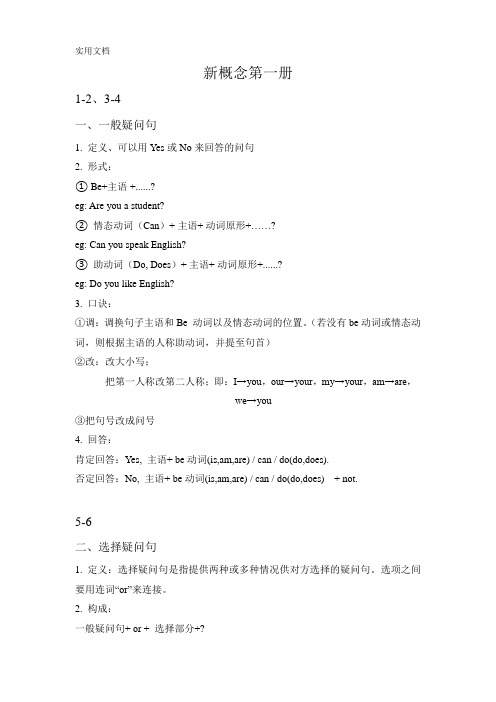
新概念第一册1-2、3-4一、一般疑问句1. 定义、可以用Yes或No来回答的问句2. 形式:① Be+主语 +......?eg: Are you a student?②情态动词(Can)+ 主语+ 动词原形+……?eg: Can you speak English?③助动词(Do, Does)+ 主语+ 动词原形+......?eg: Do you like English?3. 口诀:①调:调换句子主语和Be 动词以及情态动词的位置。
(若没有be动词或情态动词,则根据主语的人称助动词,并提至句首)②改:改大小写;把第一人称改第二人称;即:I→you,our→your,my→your,am→are,we→you③把句号改成问号4. 回答:肯定回答:Yes, 主语+ be动词(is,am,are) / can / do(do,does).否定回答:No, 主语+ be动词(is,am,are) / can / do(do,does) + not.5-6二、选择疑问句1. 定义:选择疑问句是指提供两种或多种情况供对方选择的疑问句。
选项之间要用连词“or”来连接。
2. 构成:一般疑问句+ or + 选择部分+?例:Are you a doctor or a teacher? 你是一个医生还是教师?Does he like this or that? 他喜欢这个还是喜欢那个?Is that coffee yours or hers? 这咖啡是你的还是她的?注:有时候选择部分会用“or not”来表示例:Are you ready or not (ready) ? 你准备好没有?Do you like the film or not? 你喜不喜欢这部电影?7-8、11-12、13-14三、特殊疑问句1. 含义:以特殊疑问词开头的疑问句。
2. 构成:特殊疑问词+一般疑问句+?3. 特殊疑问词总结:(1) what 什么(职业,姓名等)what day 星期几What day is it today? 几天星期几?what size 多大尺码What size are your shoes? 你的鞋码多大?what time 什么时间What time is it now? 现在几点了?what colour 什么颜色What color is your schoolbag? 你的书包是什么颜色?(2) when 什么时候(就时间提问)When will you visit Beijing? 你什么时候去北京玩?(3) where 什么地方(就地点提问)Where is your hometown? 你的家乡在哪?(4) who 谁(问人的身份,姓名等)Who is the girl in red dress? 穿着红裙子的女生是谁?(5) whose 谁的(whose + n.)Whose book is this?这是谁的书?(6) which 哪一个;哪些Which one is your sister ? 哪一个是你姐姐?(7) why 为什么(就原因提问,常用because回答)Why did you break the window?你为什么要打破窗户?(8) how 怎么样How do you go to school? 你怎么去学校?how many多少(提问可数名词数量)How many books do you have ?你有几本书?how much 多少(提问不可数名词数量)How much water is there in the glass?玻璃杯里有多少水?how much 多少钱(提问价格)How much is the ruler? 这把尺子多少钱?how old 几岁(提问年龄)How old are you? 你多少岁了?how long 多长(提问长度)How long is this ruler? 这把尺子有多长?多长时间(时间持续多久)How long do you go to school? 你去学校要多长时间?how often 多久一次(提问频率既单位时间发生多少次)how soon (还要多久时间才能开始或结束)How soon will he come back? 他多久才能回来?how heavy(提问有多重)How heavy is the luggage?这个行李箱有多重?9-10四、祈使句1. 定义:用于表达命令、请求、劝告、警告等的句子叫做祈使句。
新概念英语第一册语法知识点
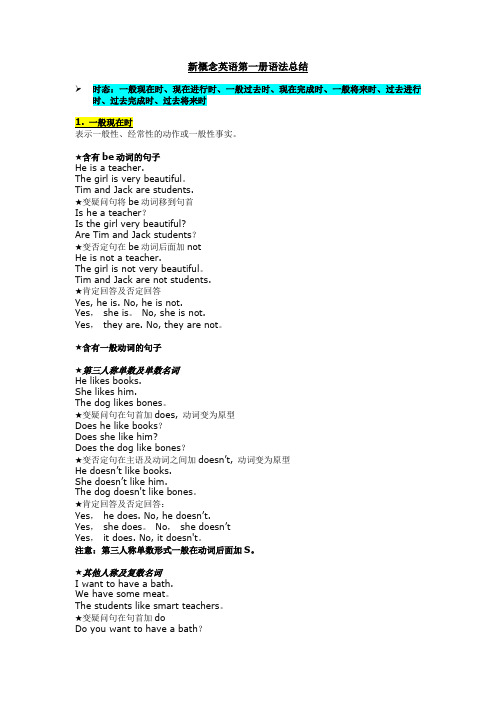
新概念英语第一册语法总结➢时态:一般现在时、现在进行时、一般过去时、现在完成时、一般将来时、过去进行时、过去完成时、过去将来时★含有be动词的句子He is a teacher.The girl is very beautiful。
Tim and Jack are students.★变疑问句将be动词移到句首Is he a teacher?Is the girl very beautiful?Are Tim and Jack students?★变否定句在be动词后面加notHe is not a teacher.The girl is not very beautiful。
Tim and Jack are not students.★肯定回答及否定回答Yes, he is. No, he is not.Yes,she is。
No, she is not.Yes,they are. No, they are not。
★含有一般动词的句子★第三人称单数及单数名词He likes books.She likes him.The dog likes bones。
★变疑问句在句首加does, 动词变为原型Does he like books?Does she like him?Does the dog like bones?★变否定句在主语及动词之间加doesn’t, 动词变为原型He doesn’t like books.She doesn’t like him.The dog doesn't like bones。
★肯定回答及否定回答:Yes,he does. No, he doesn’t.Yes,she does。
No,she doesn’tYes,it does. No, it doesn't。
注意:第三人称单数形式一般在动词后面加S。
★其他人称及复数名词I want to have a bath.We have some meat。
新概念第一册语法知识点汇总(完美版)

新概念第一册1-2、3-4一、一般疑问句1. 定义、可以用Yes或No来回答的问句2. 形式:① Be+主语 +......?eg: Are you a student?②情态动词(Can)+ 主语+ 动词原形+……?eg: Can you speak English?③助动词(Do, Does)+ 主语+ 动词原形+......?eg: Do you like English?3. 口诀:①调:调换句子主语和Be 动词以及情态动词的位置。
(若没有be动词或情态动词,则根据主语的人称助动词,并提至句首)②改:改大小写;把第一人称改第二人称;即:I→you,our→your,my→your,am→are,we→you③把句号改成问号4. 回答:肯定回答:Yes, 主语+ be动词(is,am,are) / can / do(do,does).否定回答:No, 主语+ be动词(is,am,are) / can / do(do,does) + not.5-6二、选择疑问句1. 定义:选择疑问句是指提供两种或多种情况供对方选择的疑问句。
选项之间要用连词“or”来连接。
2. 构成:一般疑问句+ or + 选择部分+?例:Are you a doctor or a teacher? 你是一个医生还是教师?Does he like this or that? 他喜欢这个还是喜欢那个?Is that coffee yours or hers? 这咖啡是你的还是她的?注:有时候选择部分会用“or not”来表示例:Are you ready or not (ready) ? 你准备好没有?Do you like the film or not? 你喜不喜欢这部电影?7-8、11-12、13-14三、特殊疑问句1. 含义:以特殊疑问词开头的疑问句。
2. 构成:特殊疑问词+一般疑问句+?3. 特殊疑问词总结:(1) what 什么(职业,姓名等)what day 星期几What day is it today? 几天星期几?what size 多大尺码What size are your shoes? 你的鞋码多大?what time 什么时间What time is it now? 现在几点了?what colour 什么颜色What color is your schoolbag? 你的书包是什么颜色?(2) when 什么时候(就时间提问)When will you visit Beijing? 你什么时候去北京玩?(3) where 什么地方(就地点提问)Where is your hometown? 你的家乡在哪?(4) who 谁(问人的身份,姓名等)Who is the girl in red dress? 穿着红裙子的女生是谁?(5) whose 谁的(whose + n.)Whose book is this?这是谁的书?(6) which 哪一个;哪些Which one is your sister ? 哪一个是你姐姐?(7) why 为什么(就原因提问,常用because回答)Why did you break the window?你为什么要打破窗户?(8) how 怎么样How do you go to school? 你怎么去学校?how many多少(提问可数名词数量)How many books do you have ?你有几本书?how much 多少(提问不可数名词数量)How much water is there in the glass?玻璃杯里有多少水?how much 多少钱(提问价格)How much is the ruler? 这把尺子多少钱?how old 几岁(提问年龄)How old are you? 你多少岁了?how long 多长(提问长度)How long is this ruler? 这把尺子有多长?多长时间(时间持续多久)How long do you go to school? 你去学校要多长时间?how often 多久一次(提问频率既单位时间发生多少次)how soon (还要多久时间才能开始或结束)How soon will he come back? 他多久才能回来?how heavy(提问有多重)How heavy is the luggage?这个行李箱有多重?9-10四、祈使句1. 定义:用于表达命令、请求、劝告、警告等的句子叫做祈使句。
(完整版)新概念英语1A知识点总结
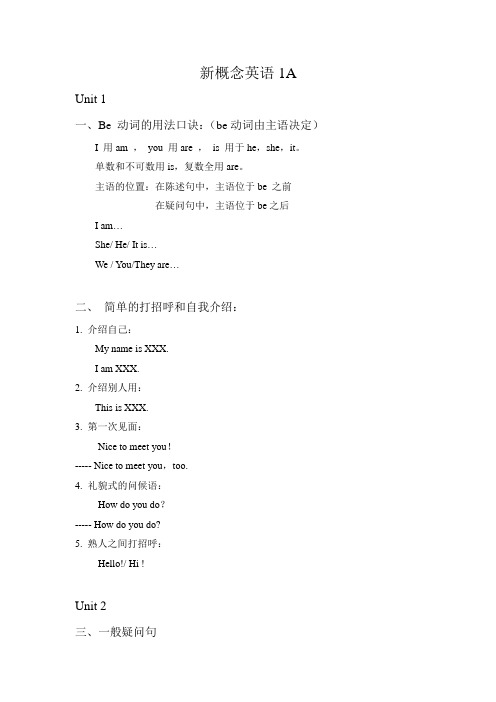
新概念英语1A Unit 1一、Be 动词的用法口诀:(be动词由主语决定)I 用am ,you 用are ,is 用于he,she,it。
单数和不可数用is,复数全用are。
主语的位置:在陈述句中,主语位于be 之前在疑问句中,主语位于be之后I am…She/ He/ It is…We / You/They are…二、简单的打招呼和自我介绍:1. 介绍自己:My name is XXX.I am XXX.2. 介绍别人用:This is XXX.3. 第一次见面:Nice to meet you!----- Nice to meet you,too.4. 礼貌式的问候语:How do you do?----- How do you do?5. 熟人之间打招呼:Hello!/ Hi !Unit 2三、一般疑问句1. 定义(什么叫做一般疑问句):可以用Yes或No来回答的问句。
2. 陈述句变一般疑问句步骤(怎么变?):①调:调换主语与be 的位置到句首。
②改:A:改写大小。
B:该人称:I(我)→you(你),we(我们)→you(你们),my (我的)→your(你的),am(用于I)→are(用于you等复数人称)C:将句号“.”改成问号“?”3. 回答:①肯定回答:Yes,主语+be.②否定回答:No,主语+be+not. (am与not不缩写)例:陈述句:This is my pen. 这是我的钢笔。
一般疑问句:Is this your pen? 这是你的钢笔吗?肯定回答:Yes, it is. 是的,这是我的钢笔。
否定回答:No, it is not(isn’t). 不,这不是我的钢笔。
4. Be动词的否定式:①:Be 的现在式:am , is , are②:Be 的过去式:was ,were③:否定式:is not= isn’t , are not=aren’t , am not无缩写形式四、冠词a/ an 的用法1. a + 以辅音发音开头的单词例:a hat , a man , a university [ˌju:nɪˈvɜ:səti]an + 以元音发音开头的单词例:an apple [ˈæpl] ,an orange [ˈɒrɪndʒ],an egg [eg],an uncle [ˈʌŋkl],an hour [ˈaʊə(r)]2. 单个字母出现在“Mr Li has one fox”中任何一个字母均用an例:an M an H an SUnit 3五、特问词的运用1. 特问词:What 问物(什么)How old 问年龄(多少岁)Who 问人(谁)How many/ much…?多少…?Whose 问谁的How 怎样What colour 问颜色Where 问哪里Which 哪一个(选择)When 问时间(什么时候)=what time2.例子① What is this?(问物)---- It is a bicycle. It is a silver bicycle.② Whose is this umbrella ?(问谁的)---- It’s William’s.③ What colour is Robert’s bicycle? (问颜色+问谁的)---- Robert’s bicycle is silver.六、对划线部分提问的做题技巧1. 选特问词。
新概念第一册知识点整理
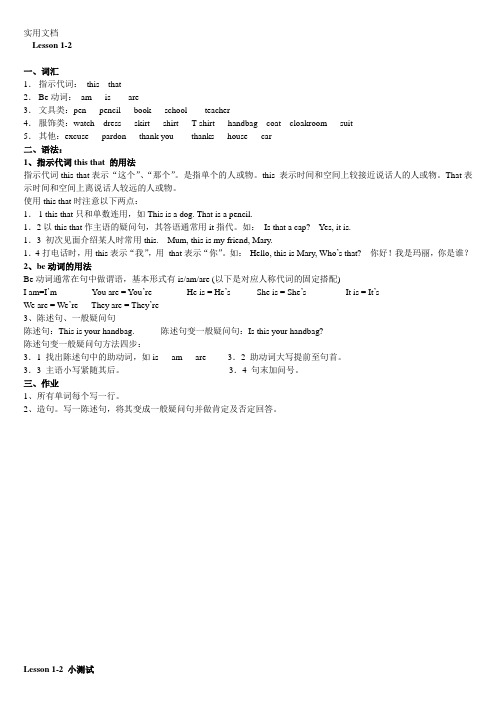
Lesson 1-2一、词汇1.指示代词:this that2.Be动词:am is are3.文具类:pen pencil book school teacher4.服饰类:watch dress skirt shirt T-shirt handbag coat cloakroom suit5.其他:excuse pardon thank you thanks house car二、语法:1、指示代词this that 的用法指示代词this that表示“这个”、“那个”。
是指单个的人或物。
this 表示时间和空间上较接近说话人的人或物。
That表示时间和空间上离说话人较远的人或物。
使用this that时注意以下两点:1.1 this that只和单数连用,如This is a dog. That is a pencil.1.2以this that作主语的疑问句,其答语通常用it指代。
如:Is that a cap? Yes, it is.1.3 初次见面介绍某人时常用this. Mum, this is my friend, Mary.1.4打电话时,用this表示“我”,用that表示“你”。
如:Hello, this is Mary, Who’s that? 你好!我是玛丽,你是谁?2、be动词的用法Be动词通常在句中做谓语,基本形式有is/am/are (以下是对应人称代词的固定搭配)I am=I’m You are = You’re He is = He’s She is = She’s It is = It’sWe are = We’re They are = They’re3、陈述句、一般疑问句陈述句:This is your handbag. 陈述句变一般疑问句:Is this your handbag?陈述句变一般疑问句方法四步:3.1 找出陈述句中的助动词,如is am are 3.2 助动词大写提前至句首。
新概念第一册语法知识点汇总(完美版)

新概念第一册1-2、3-4一、一般疑问句1. 定义、可以用Yes或No来回答的问句2. 形式:① Be+主语 +......?eg: Are you a student?②情态动词(Can)+ 主语+ 动词原形+……?eg: Can you speak English?③助动词(Do, Does)+ 主语+ 动词原形+......?eg: Do you like English?3. 口诀:①调:调换句子主语和Be 动词以及情态动词的位置。
(若没有be动词或情态动词,则根据主语的人称助动词,并提至句首)②改:改大小写;把第一人称改第二人称;即:I→you,our→your,my→your,am→are,we→you③把句号改成问号4. 回答:肯定回答:Yes, 主语+ be动词(is,am,are) / can / do(do,does).否定回答:No, 主语+ be动词(is,am,are) / can / do(do,does) + not.5-6二、选择疑问句1. 定义:选择疑问句是指提供两种或多种情况供对方选择的疑问句。
选项之间要用连词“or”来连接。
2. 构成:一般疑问句+ or + 选择部分+?例:Are you a doctor or a teacher? 你是一个医生还是教师?Does he like this or that? 他喜欢这个还是喜欢那个?Is that coffee yours or hers? 这咖啡是你的还是她的?注:有时候选择部分会用“or not”来表示例:Are you ready or not (ready) ? 你准备好没有?Do you like the film or not? 你喜不喜欢这部电影?7-8、11-12、13-14三、特殊疑问句1. 含义:以特殊疑问词开头的疑问句。
2. 构成:特殊疑问词+一般疑问句+?3. 特殊疑问词总结:(1) what 什么(职业,姓名等)what day 星期几What day is it today? 几天星期几?what size 多大尺码What size are your shoes? 你的鞋码多大?what time 什么时间What time is it now? 现在几点了?what colour 什么颜色What color is your schoolbag? 你的书包是什么颜色?(2) when 什么时候(就时间提问)When will you visit Beijing? 你什么时候去北京玩?(3) where 什么地方(就地点提问)Where is your hometown? 你的家乡在哪?(4) who 谁(问人的身份,姓名等)Who is the girl in red dress? 穿着红裙子的女生是谁?(5) whose 谁的(whose + n.)Whose book is this?这是谁的书?(6) which 哪一个;哪些Which one is your sister ? 哪一个是你姐姐?(7) why 为什么(就原因提问,常用because回答)Why did you break the window?你为什么要打破窗户?(8) how 怎么样How do you go to school? 你怎么去学校?how many多少(提问可数名词数量)How many books do you have ?你有几本书?how much 多少(提问不可数名词数量)How much water is there in the glass?玻璃杯里有多少水?how much 多少钱(提问价格)How much is the ruler? 这把尺子多少钱?how old 几岁(提问年龄)How old are you? 你多少岁了?how long 多长(提问长度)How long is this ruler? 这把尺子有多长?多长时间(时间持续多久)How long do you go to school? 你去学校要多长时间?how often 多久一次(提问频率既单位时间发生多少次)how soon (还要多久时间才能开始或结束)How soon will he come back? 他多久才能回来?how heavy(提问有多重)How heavy is the luggage?这个行李箱有多重?9-10四、祈使句1. 定义:用于表达命令、请求、劝告、警告等的句子叫做祈使句。
新概念英语第一册语法知识点

新概念英语第一册语法总结时态:一般现在时、现在进行时、一般过去时、现在完成时、一般将来时、过去进行时、过去完成时、过去将来时1. 一般现在时★含有be动词的句子He is a teacher.The girl is very beautiful.Tim and Jack are students.★变疑问句将be动词移到句首Is he a teacher?Is the girl very beautiful?Are Tim and Jack students?★变否定句在be动词后面加notHe is not a teacher.The girl is not very beautiful.Tim and Jack are not students.★肯定回答及否定回答Yes, he is. No, he is not.Yes, she is. No, she is not.Yes, they are. No, they are not.★含有一般动词的句子★第三人称单数及单数名词He likes books.She likes him.The dog likes bones.★变疑问句在句首加does, 动词变为原型Does he like books?Does she like him?Does the dog like bones?★变否定句在主语及动词之间加doesn’t, 动词变为原型He doesn’t like books.She doesn’t like him.The dog doesn’t like bones.★肯定回答及否定回答:Yes, he does. No, he doesn’t.Yes, she does. No, she doesn’tYes, it does. No, it doesn’t.注意:第三人称单数形式一般在动词后面加S。
★其他人称及复数名词I want to have a bath.We have some meat.The students like smart teachers.★变疑问句在句首加doDo you want to have a bath?Do we have any meat?Do the students like smart teachers?★变否定句在主语和动词之间加don’t.You don’t want to have a bath.We don’t have any meat.The students don’t like smart teachers.★肯定回答及否定回答Yes, I do. No, I don’t.Yes, we do. No, we don’tYes, they do. No, they don’t.构成:主语+be动词+动词的现在分词+其它成分We are having lunch.He is reading a book.The dog is running after a cat.The boys are swimming across the river.★变疑问句将be动词移到句首Are we having lunch?Is he reading a book?Is the dog running after a cat?Are the boys swimming across the river?★变否定句在be动词后面加notWe are not having lunch.He is not reading a book.The dog is not running after a cat.The boys are swimming across the river.★特殊疑问句:what, which, how, where, who, etc.疑问词+be动词+主语+现在分词What are you doing?What is she doing?What is the dog doing没有进行时的动词(必背)表示状态、思想、感情、感觉的动词不能表示正在进行的动作1. 表示感觉、感官的词see, hear, like, love, want2. have, has作为动词”拥有”的含义时,没有进行时常和表示过去的时间状语连用,如yesterday, last night, the day before yesterday, three days ago.含有be动词的句子,将动词变为过去式,am / is的变为was,are的变为wereI was at the butcher’s.You were a student a year ago.The teacher was very beautiful ten years ago.★变疑问句将be动词移动到句首Were you at the butcher’sWere you a student a year agoWas the teacher very beautiful ten years ago★变否定句在be动词后面加notI was not at the butcher’s.You were not a student a year ago.The teacher was not very beautiful ten years ago.★肯定回答否定回答Yes, I was. No, I was not.Yes, you were. No, you were not.Yes, he/she was. No, he/she was not.★特殊疑问句:What did you do?不含有be动词的句子,将动词变为过去式,动词过去式构成见附录I finished my homework yesterday.The boy went to a restaurant.The Sawyers lived at King Streeta year ago.King Streeta year ago.★变疑问句在句首加did,动词变为原型Did you finish your homework yesterday?Did the boy go to a restaurant?Did the Sawyers live at King Streeta year ago?King Streeta year ago★变否定句在主语和动词之间加did not,动词变为原型I did not finish my homework yesterday.The boy did not go to a restaurant.The Sawyers did not live at King Streeta year ago.King Streeta year ago.★肯定回答及否定回答Yes, I did. No, I didn’t.Yes, he did. No, he didn’t.Yes, they did. No, they did not.have/has+过去分词用法:1)表示过去发生且和现在有某种联系的动作,常和just, usually, already, since等时间副词连用I have just had lunch. (饱了,不用再吃了)He has had a cup of tea.(不渴了,不用再喝)They have already had their holiday. (不能再度假了)The boy has already read the book. (已经知道书的内容了,不用再看了)2)询问别人是否做过某事一般用现在完成时Have you finished your homework?Have you been to Beijing?Have he seen the film?3)表示开始于过去并持续到现在的动作I have lived in Beijing for twenty years.I have worked for this school for 1 year.4)表示一种经历、经验:去过…地方,做过…事情,经历过…事情I have never had a bath.I have never seen a film.I have never been to cinema.I have ever been to Paris.Have been to表示去过,have gone to 表示去了I have been to London.(人已经回来)He has gone to London.(人还在那里)5)表示一种结果,一般不和时间副词联用I have lost my pen.I have hurt myself.He has become a teacher.She has broken my heart.句型变化:★变疑问句将助动词移到句首,变否定句在助动词后面加not.Have you lost your pen I have not lost my pen.★肯定回答及否定回答Yes, I have. No, I have not.★特殊疑问句:What have you done?What has he done一般过去时与现在完成时的区别:凡是有明确的表示过去的时间状语的句子为过去时注意:有些动词表示的动作有一个终点,不能再延续,因此不能和表示一段时间状语连用错:I’ve left Beijing for 3 days.对:I left Beijing 3 days ago. I have been away from being for 3 days.经常和tomorrow, next year, the day after tomorrow, the year after the next, in five hours’ time, etc. 表示将来的词联用结构:主语+助动词will+动词原形I will go to America tomorrow.The pilot will fly to Japan the month after the next.Jack will move into his new house tomorrow morning.★变疑问句将助动词移到句首Will you go to America tomorrow?Will the pilot fly to Japan the month after the next?Will Jack move into his new house tomorrow morning?★变否定句在助动词后面加notI will not go to America tomorrow.The pilot will not fly to Japan the month after the next.Jack will not move into his new house tomorrow morning★肯定回答及否定回答Yes, I will. No, I will not.Yes, he/she will. No, he/she will not.Yes, he will. No, he will not.★特殊疑问句:What will you do结构:had+过去分词After she had finished her homework, she went shopping.They had sold the car before I asked the price.The train had left before I arrived at the station.After/before引导的时间状语从句放在句首要在句子后面加逗号,如果放在主句后则不用。
- 1、下载文档前请自行甄别文档内容的完整性,平台不提供额外的编辑、内容补充、找答案等附加服务。
- 2、"仅部分预览"的文档,不可在线预览部分如存在完整性等问题,可反馈申请退款(可完整预览的文档不适用该条件!)。
- 3、如文档侵犯您的权益,请联系客服反馈,我们会尽快为您处理(人工客服工作时间:9:00-18:30)。
第一册重点语法知识点都包含:时态:一般现在时,现在进行时,现在完成时,一般过去时,过去进行时,过去完成时,一般将来时,过去将来时。
词性:动词现在分词、动词的过去式和过去分词。
形容词、副词的比较级与最高级。
助动词、情态动词、半情态动词的使用。
动词不定式。
反身代词、不定代词。
特殊疑问词。
句式:简单句、并列句、复合句(定语从句、状语从句、宾语从句)。
语态:被动语态。
结构:There be结构。
语序:倒装。
(新概念英语一册1-144课的所固定搭配短语)I beg your pardon 请您在重复(说)一遍 Nice to meet you(too)(我也)很高兴见到你Look at…看… How do you do 你好 Be careful 小心A loaf of 一个 A bar of 一条 A bottle of 一瓶 A pound of一磅 Half a pound of 半磅 A quarter of 四分之一 A tin of 一听 Hurry up 快点 Next door 隔壁 Black coffee 不加牛奶的咖啡White coffee 加牛奶的咖啡 Come home from school 放学回家Come home from work 下班回家 At the moment 此刻What‟s the time? 几点钟? Come upstairs 上楼 Come downstairs 下楼Hundreds of…数以百计的… On the way home 在回家的途中This morning 今天早晨 This afternoon 今天下午This evening 今天晚上 tonight 今天夜里Yesterday morning 昨天早晨 Yesterday afternoon 昨天下午 Yesterday evening昨天晚上 Last night 昨天夜里The day before yesterday in the morning 前天早晨The day before yesterday in the afternoon 前天下午The day before yesterday in the evening 前天晚上The night before last 前天夜间A low mark 分数很底 A high mark 分数很高 She said to herself 她心中暗想 The way to…到…的走法In fashion 流行的,时髦的 I‟m afraid…我恐怕…I‟m sure…我确信,我肯定… A lot of 许多(用于肯定句) At all 丝毫、更本、一点也不 Going on holiday 度假Have been to…到过… All the time 一直,始终Have been to…到过… Drive into…撞倒…For sale 供出售、出售 Have the last word 最后决定、最后才算The R.A.F. 英国皇家空军 Return ticket 往返票Next door to…与…相邻,在…隔壁 In five hours‟time 在五小时之后。
Go back 返回 The othe day 几天前Fell downstairs 从楼上摔下来 The Y.H.A. 青年招待所协会Cheer up 振作起来 Full of…充满了…Would you like…? 你愿意…?Could you…? 你能…?(比Can you…?更婉转客气)Buy…on instalments 以分期付款的方式购买… Small change 零钱Go back to sleep 继续睡觉 To take…with…把…带上(with后跟人称宾格)Have to 不得不(过去式Had to)By myself 我自己 By yourself 你自己 By himself 他自己 By herself 她自己 By itself 它自己 By ourselves 我们自己 By yourselves 你们自己 By themselves 他/她/它们自己 By oneself 独自的Not that long ago 没那么久He can‟t be…他不可能… He must be 他肯定是…He can‟t have been…他那时不可能…He must have benn…他那时肯定是…Don‟t be so sure 别那么肯定 He may…他可能…He might…他可能…(没有He might…的程度强)Make up…minds打定主意(up后跟人称宾格) Look after 照看In the end 最后 In the first instance 首先,起初He may be…他可能是 He may have been他可能己经…I‟m ot sure 我不敢肯定 I wonder why 我想知道为什么A long time (ago) 很早(前) Get married 结婚Depend on…依靠,取决于… I‟m late for…我因为…而迟到By the way 顺便(问,说) I‟m dressed in…我穿戴着…Make up her face 往她的脸上施脂粉Make myselft beautiful 把自己打扮漂亮 Was covered with…覆盖着…I went for…(…表明目的) Pice of paper 纸片 Cigarette ends 烟头 Take out 拿出 Put away 放到一边 Hundreds of…成百上千的… Round the world 周游世界季节、月份、星期Spring 春节 Summer 夏天 Autumn 秋天 Winter 冬天January 一月 February 二月 March 三月 April 四月 May 五月 June 六月 July 七月 August 八月 September 九月October 十月 November 十一月 December 十二月 Monday 星期一 Tuesday 星期二 Wednesday 星期三 Tursday 星期四 Friday 星期五 Saturday 星期六 Sunday 星期日 Weekend 周未(请记住以下特殊疑问句的特殊疑问词)1、 Why (有关原因)2、 What (有关事物)3、 Which (有关事物)4、 Who (有关人物)5、 Whose (有关人物)6、 Where (有关地点)7、 When (有关时间)8、 How (有关方法或状态)第一部份:词法(请记注以下词性概念,具体的用法参考我们所学过的课文)一、动词:(表示动作或状态等。
)1、记住以下常见系动词Appear Be Become Fall Feel GetGo Grow Keep Look Prove Remain Rest Run Seem Smell Sound Stay Taste Rurn 2、记住以下常见助动词Be Have Do Will Sould Shall Should 3、记住以下常见情态动词Can Could May Might Must Ought 4、记住以下常见半情态动词Need Dare Be able to Have(got)to Had better(best) Used to二、冠词(用在名词前帮助说明其词义)三、名词(表示人或事物的名称)四、代词(用来代替名词或数词等,包含反身代词)五、形容词(用来修饰名词或代词)六、副词(用来修饰动词、形容词、或副词)七、介词(用在名词、代词等前面,表示与别的词的关系)八、数词(表示数目或顺序)九、连词(用来加接词与词或句与句)十、感叹词(表示说话时的感情或口气)第二部分:词法规则一、可数名词的复数规则变化1、一般情况下未尾加“s”。
2、以x,ss,sh,ch,x结尾的名词加“es”。
3、以ce,se,ze,(d)ge结尾的词加“s”。
4、以辅音字母+y结尾的词,变“y”为“i”在加“es”。
5、以元音字母+y结尾的词,直接加“s”。
6、以f,fe结尾的名词一般变“f”或“fe”为“v”在加“es”。
(以f或fe结尾的部分名词可直接加“s”)7、以o结尾的名词一般加“s”。
(部分以辅音字母+o结尾的加“es”)二、规则动词的过去式与过去分词变化与动词现在分词的变化1、一般动词过去式在未尾加“ed”。
2、结尾是e的动词加“d”。
3、未尾只有一个辅音字母的重读闭音节词,先双写这个辅音字母,再加“ed”。
4、结尾是辅音字母+y的动词,先变“y”为“i”在加“ed”。
5、动词的现在分词一般情况下在原形后加“ing”。
6、如果以e结尾的动词则去“e”在加“ing”来构成现在分词。
7、如果动词只有一个元音字母,而后面跟了一个辅音字母时,则需双写辅音字母再加“ing”来构成动词的现在分词。
三、形容词与副词的比较级、最高级(比较级在未尾加“er”而最高级在未尾加“est”)它们都遵循着以下规则1、一般情况下单音节的形容词或副词则在原形未尾加“er”。
2、如果以e结尾的形容词或副词则加“r”。
3、有些以y结尾的双音节词,如果y前面是一个辅音字母则变“y”为“i”在加“er”。
(如果是最高级则在形容词前加冠词“The”然后形容词或副词未尾加“est”,其它规则一样。
)第三部分:句法规则(时态)1、一般现在时:(除主语第三人称)谓语动词都使用动词原形。
常与副词“always”,“never”,“often”,“seldom”,“usually”,“every”,“day”等连用。
2、现在进行时:表示现在正在进行的动作。
语法:Be+动词现在分词3、现在完成时:表动作发生在过去,但与现在有关系。
即用一个发生在过去的动作来说明现在的情况。
语法:Have+动词过去分词4、一般过去时:表过去某个时间发生的动作或存在的状态,也表示过去常发生的动作。
语法1(be动词):主语+be动词过去式语法2:主语+动词过去式5、过去进行时:表某一时刻或某一段时间内正在进行或持续进行的作动。
语法:Be动词过去式+动词现在分词6、过去完成时:表在过去某一时间或动作以前己经完成的动作。
语法:Had+动词过去分词构成7、一般将来时:表将来某个时间要发生的动作或存在的状态,也表将来经常或反复发生的动作。
语法1:Will(Shall)+动词原形语法2:Be+going go+动词原形8、过去将来时:表从过去某一时间看将要发生的动作或存在的状态。
